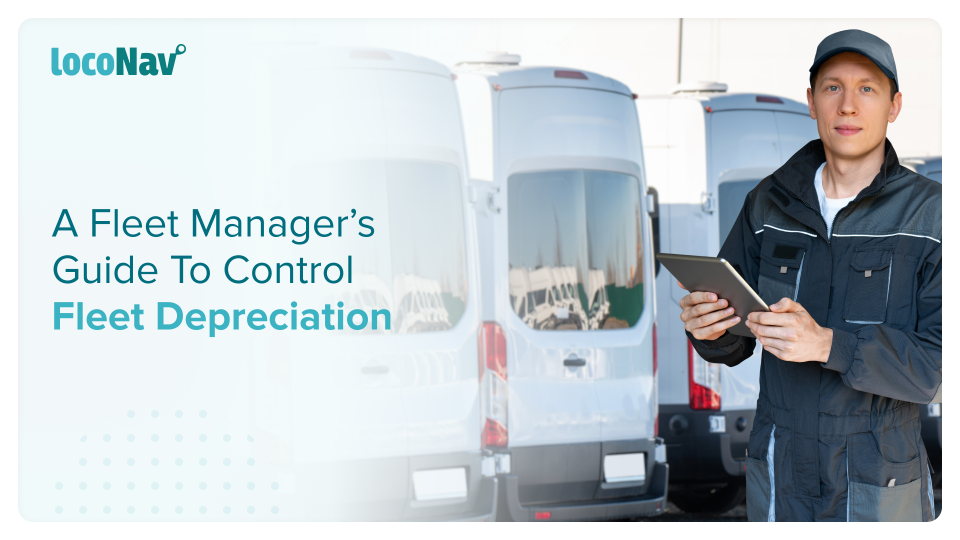

One of the most difficult challenges for a fleet manager in today’s highly competitive business environment is the fleet depreciation that occurs with each passing year for each vehicle in the fleet. Fleet depreciation is the decrease in the value of your vehicles over a specific time period, commonly in one-year increments.
Every vehicle in your fleet will lose value at a certain pace for the duration of your ownership, and the rate of devaluation will be determined by a variety of parameters such as vehicle type, age, mileage, and cost of acquisition.
The key to mitigating the effects of depreciation is to reduce capital costs while increasing the resale value of any vehicle fleet. The fundamental goal is to replace vehicles at the most cost-effective moment for the firm, which is when the lifespan cost of the vehicle is at its lowest. Any manager who can accomplish this will have reduced the impact of devaluation on that team and will be confident that they have gotten the most out of each vehicle.
In this blog, we will discuss fleet depreciation and its possible effect on your fleet.
Manage your fleet efficiently with LocoNav’s Fleet Management Solutions!
What is Vehicle Depreciation?
The valuation of an asset depreciates during its useful life. Fleet depreciation is the price difference between when you buy a vehicle and when you wish to sell it. Depreciation is affected by a variety of circumstances. Still, most vehicles lose 15 to 35 per cent of their original value in the first year and up to 50 per cent or more during the next three years. As a result, organisations must understand how to minimize depreciation while enhancing fleet efficiency.
Fleet depreciation is the most expensive expenditure for a typical fleet, with the majority occurring in the first two years of a vehicle’s life. Depreciation is unavoidable, but not impossible to overcome: understanding it better and using excellent strategies will not make it go away, but they will help you deal with it.
How to Calculate Fleet Depreciation?
The depreciation calculation is deceptively simple:
Depreciation = fleet vehicle acquisition cost – resale value + any expenses associated with the sale
However, the elements that determine the resale value and the utility generated from your fleet vehicles are numerous and complex. Vehicle depreciation is divided into two categories: utility and prestige value.
- Utility is largely a function of mileage; every kilometre you drive depreciates the vehicle, however not all miles depreciate equally over the lifecycle.
- Prestige Value is a vehicle’s perceived value, which is obviously highest shortly before it’s driven off the lot and diminishes rapidly in the first few months of ownership.
What Factors Influence Fleet Depreciation Value?
Here are some factors that influence your fleet depreciation value:
- Make and model: A vehicle with a popular make and model will likely hold its worth longer than other ones.
- Condition: A vehicle with regular wear and tear will preserve its value more than one that has been in an accident or has been used for work. A truck, for example, that is frequently driven off-road will sustain greater damage than a vehicle driven for pleasure or to and from work.
- Age: With some exceptions, the older your vehicle is, the lower its worth.
- Mileage: Vehicles have a practical upper limit on the number of kilometres they can go before requiring substantial, costly maintenance. The more kilometres a vehicle has, the less valuable it is likely to be.
How Can a Fleet Manager Optimize Vehicles to Reduce Depreciation?
If you’re a fleet manager, you’re constantly concerned about fleet vehicle depreciation. Your new vehicles will be ageing and depreciating by the kilometre before you realise it, and there will be nothing you can do about it.
With the right approach, proper management techniques, and a little help from top-of-the-line fleet management software such as LocoNav, you’ll be able to minimise the impact of depreciation and maximise your profits all year. Consider the following ideas for managing depreciation in your fleet business:
- Make Reasonable Predictions
While fleet fuel is a somewhat unpredictable expense, fleet depreciation is generally predictable if you use vehicle and market data. The market for vehicle resale value isn’t remarkably predictable, but it is transparent; you’ll be able to quickly see the present and forecast resale value of fleet vehicles of a specific make and model and mileage, and change your strategy accordingly.
- Stay Organized With A Fleet Management Software
To remain on top of repairs and monitor vehicle data, you need a strong, user-friendly fleet management system. That’s where LocoNav comes in. LocoNav, powered by AI and IoT, collects and manages all of your vital data, provides customisable car repair reminders, and enables you to run a more financially stable fleet than ever before. Take total command of your fleet.
- Maintain Your Vehicles Properly
Depreciation is just a big-picture assessment of how the value of a particular vehicle will drop – your vehicle may be worth more than its market value. Your vehicle, on the other hand, may be worth far less than market value if it has a slew of mechanical difficulties and flaws.
If you want to maintain your fleet depreciation at a consistent and predictable rate, you must take good care of them. Never overlook vehicle problems, neglect oil changes, or think “it can wait.”
- Sell At The Right Time
Selling your vehicle at the correct moment is critical for recouping the most value feasible. Vehicles still under warranty or with a restricted number of kilometres, as well as those with no history of major breakdowns or repairs, are more likely to sell over market value.
You may analyse the ideal time to sell your fleet vehicles and minimise your overall vehicle expenses year over year by integrating warranties, individual vehicle depreciation rates, and consumer data and statistics on vehicle lifespans and the likelihood of failures.
FAQ
How Depreciation is Different From Amortization?
Amortization and depreciation are two strategies for determining the worth of a company’s assets over time.
- Amortization is the technique of spreading the expense of an intangible asset over its useful life.
- Depreciation is the expense of a fixed asset to reflect its expected deterioration.
How is Fleet Depreciation Calculated?
The depreciation calculation is deceptively simple:
Depreciation = vehicle acquisition cost – resale value + any expenses associated with the sale
